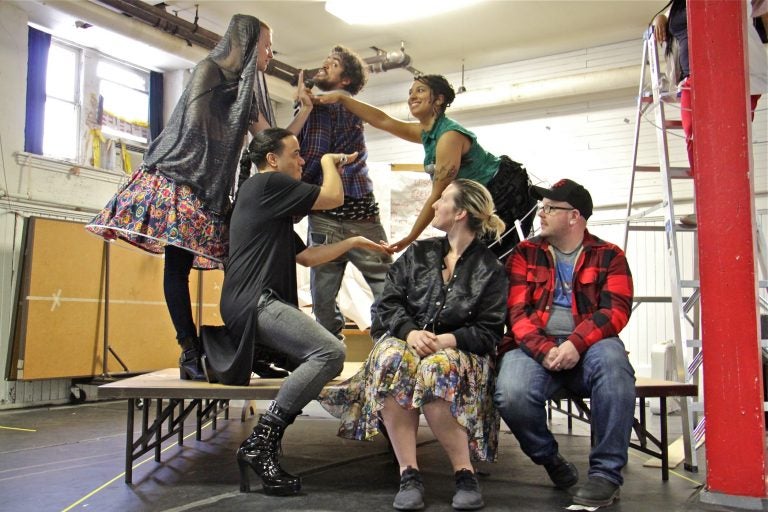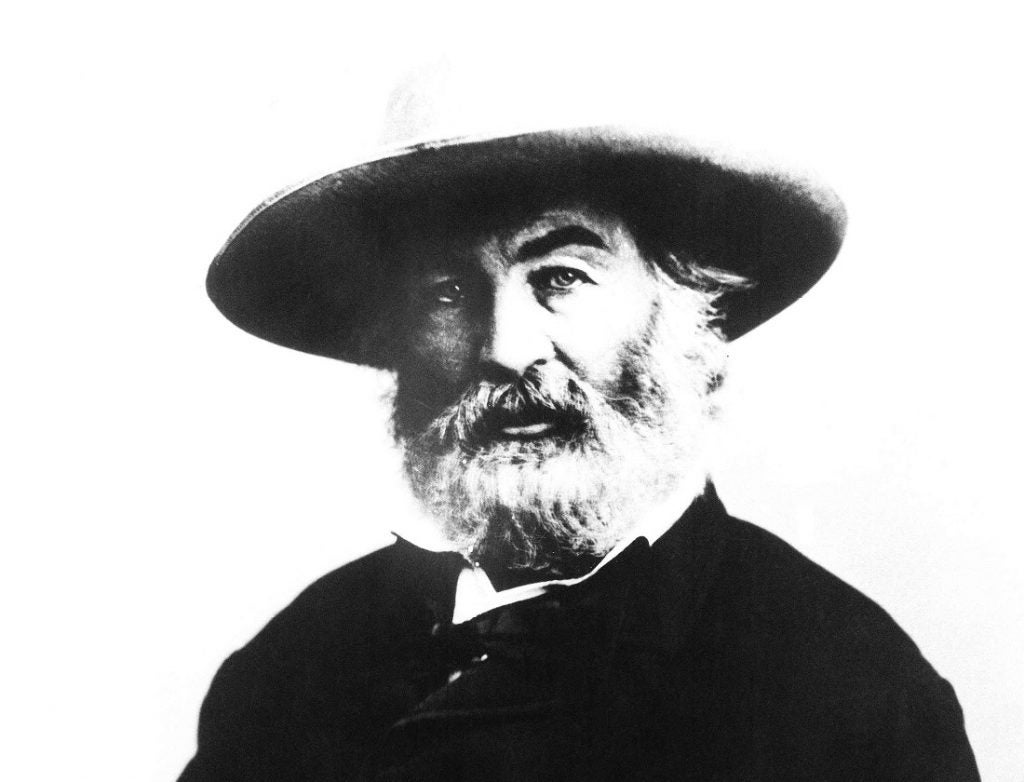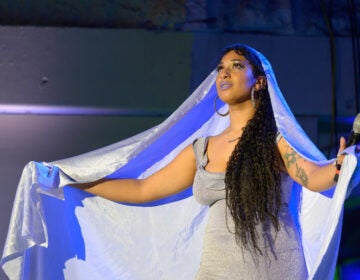Walt Whitman put on trial for his 200th birthday
Philadelphia launches a series of events for Whitman’s 200th birthday, some challenging the legacy of the “Good Gray Poet.”
Listen 5:12
Members of the Bearded Ladies Cabaret rehearse for a performance that examines Walt Whitman's legacy, " Contradict This! A Birthday Funeral for Heroes." (Emma Lee/WHYY)
When the Delaware River Port Authority opened a new bridge spanning the river in 1957, the agency had to come up with a name for it. Since there was already a bridge named after a prominent Philadelphian, Ben Franklin, the authority decided to christen the new span after a prominent Camdenite, Walt Whitman.
That decision proved immediately controversial.
The Archdiocese of Philadelphia launched a letter-writing campaign against naming a public bridge after the bohemian poet who favored the freedom of the open road and wrote:
Now I re-examine philosophies and religions,
They may prove well in lecture-rooms, yet not prove at all under the spacious clouds and along the landscape and flowing currents.
Some of those angry letters are on display at the University of Pennsylvania Library. One reason for the opposition was unsaid, but clear: Whitman was gay and didn’t hide it.
The exhibition at Penn is a small part of a city-wide celebration of Whitman’s 200th birthday. He was born May 31, 1819 in Brooklyn, and spent the last couple decades of his life in Camden, where he is buried. The Good Gray Poet died in 1892 at age 72.
Under the umbrella of Whitman@200, the Penn Libraries have coordinated dozens of events, poetry readings, workshops, and art projects created by myriad organizations across the region. The libraries also commissioned four original works: two installations, a walking performance tour, and a theatrical musical.
“What we wanted to do in the overall project was to get below the surface and ask why Whitman is relevant today,” said artistic director Judith Tannenbaum. “Not just blindly celebrate somebody because they have a famous name.”
Artist Spencer Finch created an installation on the Riverlink Ferry, which encourages people to closely observe the sky and the water — their colors change daily — as Whitman did when composing “Crossing Brooklyn Ferry.”
Another artist, Homer Jackson, organized neighborhood walking tours accompanied by church choirs and an original music composition, in the vein of “Song of the Open Road.”

‘An exploration of flawed heroes’
The Bearded Ladies Cabaret was asked to create an original musical that delved into a controversy of Whitman’s own making: his own racist leanings.
“I wanted it to be a birthday, a funeral, and a trial all in one,” said John Jarboe, the director of the Bearded Ladies. “So you get a sense of how complicated it is dealing with our ancestors. Sometimes you want to put them to rest, sometimes call them out, sometimes celebrate them, sometimes all at the same time.”
“Contradict This! A birthday funeral for heroes” is a madcap musical that starts as a birthday party for Whitman. The actors — who largely came up with their own lines — confess their first discovery of his poetry. Many of them relate that discovery to their own queer identity.
“I got my first copy of “Leaves of Grass” when I was 14,” said one performer, Pax Ressler, on stage. “I didn’t know how badly I needed it. I was desperate for queer role models and Whitman’s text was some of the only queer stuff that wouldn’t draw too much suspicion.”
The course of the play abruptly changes when the performers come upon some things Whitman wrote that are overtly racist. In one essay concerning his reservations about allowing African-Americans to vote, he wrote: “As if we had not strained the voting and digestive caliber of American Democracy to the utmost for the last 50 years with the millions of ignorant foreigners, we have now infused a powerful percentage of blacks, with about as much intellect and calibre (in the mass) as so many baboons.”
The performance then shifts into a courtroom proceeding, pitting Whitman’s legacy as a poet and champion of the outcast against his racist beliefs. The Bearded Ladies ensemble stays true to its taste for absurdity, playing the legal rituals in the courtroom for laughs, but at its core is a serious examination of how heroic historical figures can or cannot survive modern scrutiny.
The Bearded Ladies are not the first to put Walt Whitman on trial. Scholars have been discussing the Whitman contradiction for years. A collection of essays on this subject was published five years ago as “Whitman Noir: Black American and the Good Gray Poet.”
“As broad and expansive as the poetry can be, there’s a way you can read the poetry as not quite sufficient for the political changes that need to happen,” said Lavelle Porter, an assistant professor at New York City College of Technology, who teaches Whitman in his literature courses.
For some, the defense that Whitman was socially progressive for his time — post-Civil War reconstruction — does not assuage the fact that his beliefs that are considered deeply racist today.
For others, Whitman was an outsider shunned by the literary establishment of his time, who turned poetry into a personal confirmation on the most grand scale. Many poets who came later, including Langston Hughes and Margaret Walker of the Black Arts Movement, revered Whitman as a hero.
“I do think this whole piece is an exploration of flawed heroes, and in that an exploration of our own flaws,” said Jarboe. “When I say, ‘I love Whitman so much,’ and if you insult Whitman, and I defend Whitman, I’m really defending myself through the lens of this dead person.”
The Bearded Ladies are also not the only ones scrutinizing Whitman on his birthday. The Pennsylvania Academy of the Fine Arts is exhibiting a small show of artwork related to Whitman in an abstract way. There a few images depicting the poet himself, including the famous portrait by Thomas Eakins, but the bulk of the show attempts to trace his inner life via unrelated paintings from the PAFA collection.
For example, the well-known painting by Andrew Wyeth, Young America, showing a young man riding across an empty field on a shiny red bicycle with red, white, and blue streamers. It has the open road, the youth, and the certain isolation that suggests the promise of democracy rather than its actualization.
The show was assembled by PAFA Youth Council, an annual program pulling together a handful of high school students from the region to introduce them to museum work for an academic year. This exhibition was their final project.
They included a piece by Andy Warhol: a silkscreen print of an Indian Head nickel.
“We wanted to showcase how he viewed Native Americans, and bring attention to the fact that his views were not good,” said Sophia Becker of Friends Select school. “He believed Native Americans, while they had beautiful culture and did beautiful things, they were beneath white people.”
In recent years, the re-examination of historic figures has caused statues to topple. A statue of singer Kate Smith outside the sports arena in South Philadelphia was removed when the Flyers discovered she recorded a some racist songs early in her career. A lively debate has arisen around the statue of former Philadelphia Mayor Frank Rizzo across from City Hall. Statues of confederate officers have been pulled down all over the American South.
Philadelphia has two statues of Walt Whitman: a bust in Whitman Plaza on Oregon Avenue and a more prominent figure on South Broad Street in the middle of a field near the I-76 on ramp to New Jersey. A few weeks before Whitman’s birthday celebrations were to begin, the Association for Public Art gave that statue a polish.
Zack Tatti, a sculptural restorer, used a propane torch to seal new wax coat onto the figural sculpture’s surface. He unwittingly described the problem with holding your heroes too close.
“The oils in your skin and hands break down the wax we apply,” he explained. “If it’s handled enough, it can break down the wax and destroy the patina.”
WHYY is your source for fact-based, in-depth journalism and information. As a nonprofit organization, we rely on financial support from readers like you. Please give today.





